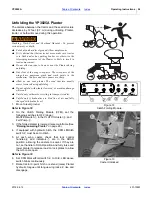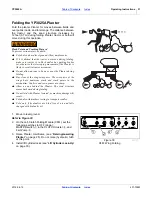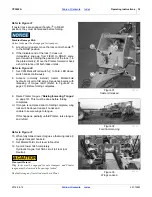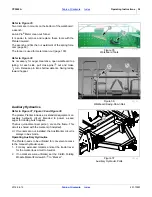
YP3025A
Operating Instructions
33
2019-06-12
401-705M
Re-phasing Fold System
In typical use during a single planting operation, it is
normal for the fold cylinders to get slightly out of phase,
resulting in uneven folding and unfolding of the planter.
Every few planting days, re-phase the cylinders with this
procedure:
1. Raise, unfold and fold the Planter completely, and
hold the fold hydraulic lever or switch in Extend for
several seconds after the Planter reaches full
folding, or until all cylinders are fully extended.
2. When all cylinders are fully extended, reverse
(Retract) the control to unfold and return to planting.
Transporting the Planter
Loss of Control Hazard:
Ensure that the towing vehicle is adequate for the task. Using
an inadequate tow vehicle is extremely unsafe, and can result
in loss of control, serious injury and death.
The Planter can weigh up to 42000 pounds (19000 kg),
depending on configuration and seed load. A 500 gallon tank
cart hitched to the Planter (“in train”) could add another
3000 pounds (1400kg) empty. The tractor unit MUST be rated
for the load. If the tractor is not rated for at least 42000
pounds, calculate or obtain a scale weight of the Planter and
cart.
Do not tow if Planter exceeds the load rating of the vehicle.
Loss of Control Hazard:
A tank cart in train must be EMPTY. A full tank cart could
weigh 3000 pounds (1400kg), and, when hitched to the
Planter, represents an unsafe highway load regardless of the
rating of the towing vehicle. If a cart must be transported
loaded, tow it separately.
Check Bridge Loads
: A loaded Planter, or a Planter with cart
in tow, can exceed the load ratings of bridges you must cross.
Loss of Control Hazard:
The CFM switch must be set to Hitch, and the hydraulic circuit
must be in FLOAT during transport. Failure to do this may
result in hydraulic system damage, transport hooks
unlatching, and major Planter/tractor damage.
Braking and Loss of Control Hazard:
Do not exceed 20 mph (32 km/h) when driving straight.
29284
Seed may be loaded prior to travel, but increases stopping
distance, increases the need for caution in turns and braking,
and increases tire wear.
32
22
5


































